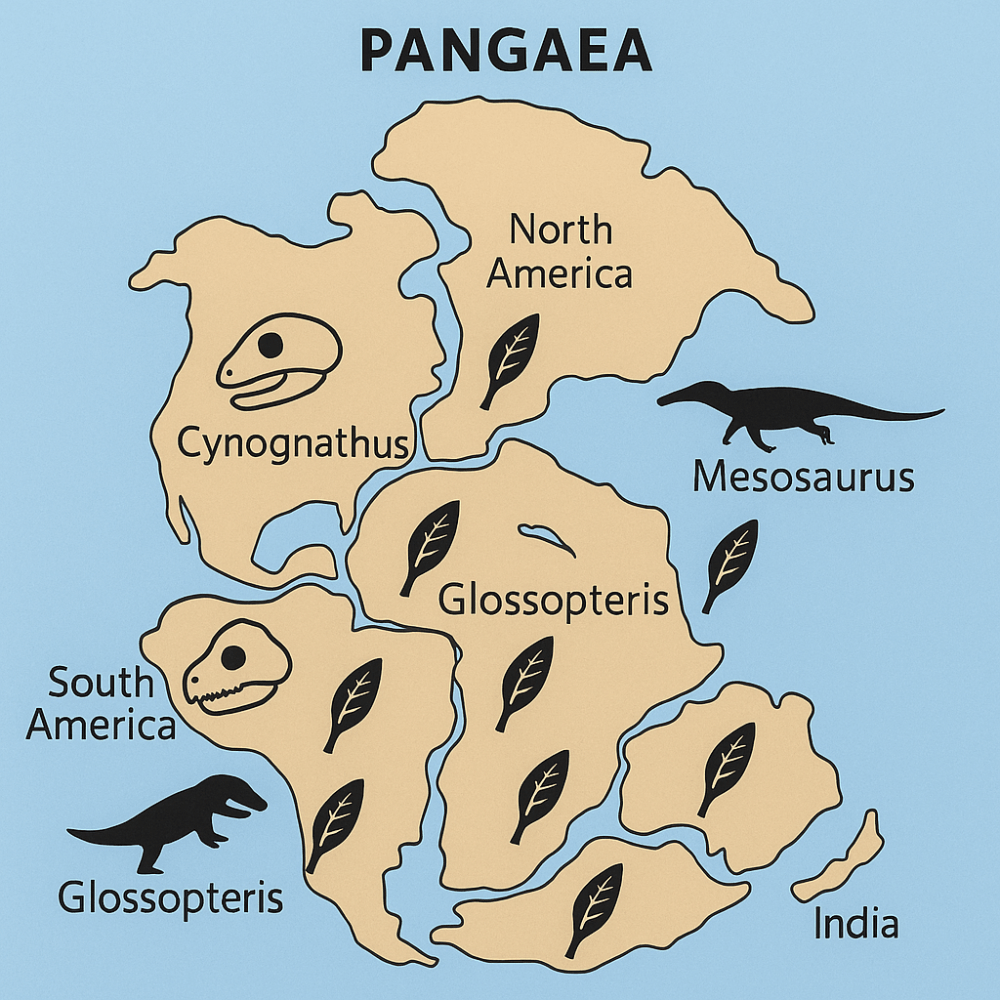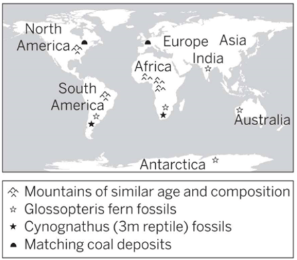Fossils of the freshwater reptile Mesosaurus are found in both South America and Africa. What does this suggest?
The continents were once joined together.
What process forms new crust at a mid-ocean ridge?
S.F.S.=Magma rising and cooling at ridges as plates move apart
At a convergent boundary, an oceanic plate collides with a continental plate. What happens?
The oceanic plate sinks beneath the continental plate and is recycled back into the mantle.
Trenches are made here as well as volcano mountains
Scientists find matching magnetic stripes on both sides of a mid-ocean ridge. What evidence does this provide?
A) The seafloor spreads outward as new crust forms.
B) The seafloor is stationary.
C) All rocks have the same magnetic direction.
D) Volcanoes occur only on land.
A) The seafloor spreads outward as new crust forms.
Why is it important for scientists to study plate motion?
It helps us predict when natural hazards will occur
Engineers studying geothermal energy want to design a power plant that uses heat from the mantle to generate electricity.
What should the engineers study first to ensure the design is efficient?
A) How convection currents transfer heat through the mantle
B) How wind currents move energy across oceans
C) How magma forms in volcanoes after eruptions
D) How sunlight warms the surface during the day
A) How convection currents transfer heat through the mantle
A volcano-monitoring network detects gas, heat, and ground motion.
Which improvement would make the system more effective?
A) Focus only on volcanoes near cities.
B) Reduce the number of sensors to save money.
C) Turn off sensors between eruptions.
D) Integrate satellite data to monitor volcanoes in remote areas.
D) Integrate satellite data to monitor volcanoes in remote areas.
Which evidence from the diagram best supports Alfred Wegner's theory of continental drift? 
Matching fossils were found on continents that were once connected
The age of oceanic crust increases as you move away from a mid-ocean ridge. What does this pattern show?
A) New crust forms at the ridge and pushes older crust outward.
B) The ocean floor is shrinking.
C) Crust forms only near subduction zones.
D) Earth’s crust never changes.
A) New crust forms at the ridge and pushes older crust outward.
Which landforms are created at subduction zones?
Trenches
Why do some convergent boundaries produce volcanoes while others only form mountains?
A) Mountains form only at transform boundaries with little heat transfer.
B) All convergent boundaries produce volcanoes, but some are hidden underwater.
C) Volcanoes form when two continental plates collide and magma cools at the surface.
D) Volcanoes form when oceanic crust sinks under continental crust, melting into magma.
D) Volcanoes form when oceanic crust sinks under continental crust, melting into magma.
Engineers are improving earthquake warning systems. Which step will make their design most effective?
A) Identify technology limits and how quickly warnings can reach people.
B) Assume all earthquakes have the same strength.
C) Wait to test the system until a large earthquake happens.
D) Focus only on cities far from plate boundaries.
A) Identify technology limits and how quickly warnings can reach people.
Scientists are creating a model of Earth’s crust to show how material moves over time. Which process must be included to make the model realistic?
A)Rotation of Earth around the Sun
B) Erosion by wind and rain only
C) The freezing and melting of glaciers
D) Crust creation and destruction at plate boundaries
D) Crust creation and destruction at plate boundaries
Scientists are creating a digital model of seafloor spreading. What variable must they include for accuracy?
A)The color of ocean water
B)The amount of rainfall each year
C)The rate of magma rise and cooling at mid-ocean ridges
D) The number of ships crossing the ocean
C)The rate of magma rise and cooling at mid-ocean ridges
Alfred Wegener’s idea of continental drift wasn’t accepted at first because...
A) He couldn’t explain what force moved the continents.
B) He didn’t collect any evidence.
C) He thought continents floated on water.
D) He only studied European fossils.
A) He couldn’t explain what force moved the continents.
Why does magma rise toward the surface at divergent boundaries?
A) It is less dense than the surrounding rock.
B) It is pulled upward by gravity.
C) It is pushed by earthquakes.
D) It is magnetically attracted to the crust.
A) It is less dense than the surrounding rock.
The process is called subduction and the denser plate sinks back into the mantle and is heated back up into magma.
What happens when convection currents in the mantle move in opposite directions?
Plates will move apart at a divergent boundary
Scientists install instruments to monitor ground movement near a subduction zone. The sensors detect rising magma pressure, but a large eruption doesn’t occur.
What does this event show about predicting volcanic activity?
A) Earthquakes must happen before any eruption can occur.
B) Scientists can always predict exactly when a volcano will erupt.
C) Monitoring systems cause the pressure to release safely.
D)Data helps identify potential hazards, but exact timing can’t be predicted.
D)Data helps identify potential hazards, but exact timing can’t be predicted.
Students design two models to show convection currents in the mantle.
Model 1: Heated water in a clear tank with food coloring to show rising and sinking currents.
Model 2: A map showing only plate boundaries Which statement best explains which model better represents mantle motion?
A) Model 1, because it shows energy transfer and material movement
B) Model 2, because it focuses on tectonic plates
C) Model 1, because it shows volcanoes forming
D) Model 2, because it includes land and oceans
A) Model 1, because it shows energy transfer and material movement
A student model shows arrows for plate movement but does not include the mantle below the crust.
How could the student improve this model?
A) Add convection currents to show energy transfer in the mantle.
B) Add more arrows for continents only.
C) Label oceans instead of showing currents.
D) Remove the crust to simplify the model.
A) Add convection currents to show energy transfer in the mantle.
Fossils of tropical plants are found in Antarctica. What can scientists infer?
Antarctica used to be closer to the equator making it a warmer climate.
What is the main energy source driving plate motion?
Heat from the Earth's core
Why is the Earth not getting larger even though new crust forms at mid-ocean ridges?
Old crust is destroyed at subduction zones at the same time new crust is made in another part of the world.
A chain of volcanoes forms along the edge of a continent where an oceanic plate is sinking beneath it. Which statement best explains why earthquakes and volcanoes both occur in this region?
A) The continental plate pulls apart, allowing magma to rise easily.
B) Subduction causes friction and melting as the plate sinks into the mantle.
C) Ocean water cools the magma, causing it to solidify under pressure.
D) Wind erosion removes crust, exposing magma chambers.
B) Subduction causes friction and melting as the plate sinks into the mantle.
A volcanic island experiences an increase in gas emissions and small tremors for several weeks, but no eruption follows. Scientists adjust their prediction models.
What does this scenario show about forecasting natural hazards?
A) Earth’s systems are completely unpredictable, so forecasting is useless.
B) Once an eruption warning is issued, it always means a volcano will erupt.
C)Predictions improve as scientists collect and revise data from real events.
D) Volcanic eruptions only occur when magma pressure suddenly drops.
C)Predictions improve as scientists collect and revise data from real events.
Why is it important for geologists to know that convection in the mantle transfers heat from Earth’s core to the surface?
It shows scientists how plates move and how new crust is formed and old crust is recycled.
After analyzing earthquake data, engineers notice certain bridges collapse during quakes.
What is the best next step to improve bridge design?
A) Focus only on bridge color and weight.
B) Use the same design but increase bridge length.
C) Test bridge models only during mild weather.
D)Identify material and structural constraints that affect earthquake resistance
D)Identify material and structural constraints that affect earthquake resistance
 Glossopteris and Lystrosaurus fossils across several continents. Which continents were likely connected based on this fossil evidence?
Glossopteris and Lystrosaurus fossils across several continents. Which continents were likely connected based on this fossil evidence?
North America and Europe were once connected, as were South America, Africa, India, Australia, and Antarctica.
Explain the process that drives plate motion?
In other words what is the thing that causes the crust to move and explain how it works.
Convection in the mantle. Hot magma is less dense and rises. As it cools it becomes more dense and sinks. This movement moves the plates on top of the mantle.
Scientists studying a coastal region find: Deep earthquakes occur offshore. A chain of volcanoes lines the coast. GPS data shows one plate is moving beneath another.
Which conclusion is best supported by this data?
A) The region is located near a subduction boundary where one plate sinks under another.
B) The region is located near a divergent boundary where new crust forms.
C) The region sits on a transform boundary where plates slide past each other.
D) The region has no tectonic activity; these patterns are random.
A) The region is located near a subduction boundary where one plate sinks under another.
Two plates slide past each other without creating or destroying crust. Over time, stress builds along the fault until it suddenly releases energy.
Which hazard is most directly caused by this process?
Earthquake
Engineers are designing an early-warning system for earthquakes in a transform fault zone. Which factor should they consider a constraint in their design?A)The political boundaries between nearby countries.
B) The color and material used for housing the sensors.
C) The speed at which seismic waves travel through Earth’s crust.
D) The number of weather satellites in orbit.
C) The speed at which seismic waves travel through Earth’s crust.
A group of engineers notice that an earthquake warning system fails to reach people in rural areas.
What should they do to improve the system?
A) Wait for a larger earthquake to test it again.
B)Evaluate communication constraints and add local alert networks.
C) Focus only on cities near the ocean.
D) Assume everyone uses smartphones.
B) Evaluate communication constraints and add local alert networks.
Why do most earthquakes occur near plate boundaries?
A) Stress builds up where plates move against each other.
B) Earthquakes only happen near volcanoes.
C) The crust is thicker at boundaries.
A) Stress builds up where plates move against each other.